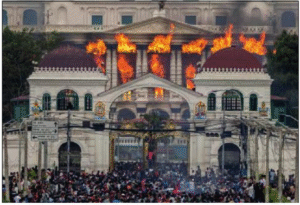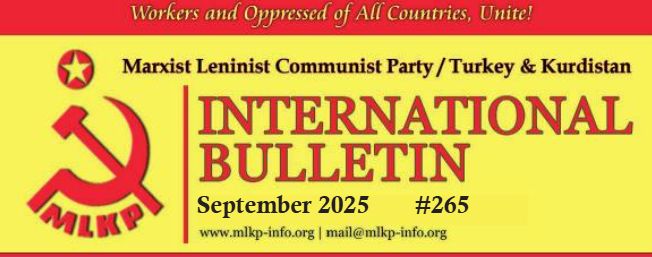The popular uprising that began in Nepal on September 7 led to the overthrow of the government and the dissolution of parliament within 48 hours. The protests started in response to the government’s decision to ban social media. The protests quickly turned against the government, demanding the reopening of social media and an end to corruption. Since the majority of the insurgents were between 15 and 30 years old, the uprising was dubbed a “Gen Z” revolt. Violent police attacks on the protesters and the resulting deaths intensified the anger. The insurgents set fire to government buildings, including the parliament building and the Supreme Court, persecuted government officials, beat ministers, stormed police stations, and disarmed police officers. The army initially held back, only taking control after the first wave of the uprising had largely subsided.
The insurgents declared that they would not speak to anyone except the army. After negotiations between the insurgents and the army, the former president of the Supreme Court was appointed interim prime minister. The social media ban sparked the uprising, but it was just the last straw. After the “Nepo Kids” movement exposed the luxurious lifestyles of the children of bourgeois politicians, who officially received a salary of $150 per month, the social media ban was seen not only as censorship but also as an attempt to cover up corruption.
Sixty-five percent of Nepal’s 30 million inhabitants are under 30 years old. More than 20% of young people aged 15 to 24 are unemployed. Hopelessness, insecurity, and poverty are the central issues facing young people. In contrast, the lavish lifestyles of the children of bourgeois politicians, alongside nepotism and corruption, have contributed significantly to the anger of the younger generation.
Previously conducted anti-corruption programs, both organized and unorganized, as well as street actions, helped prepare the ground for the uprising. It had often been stated that “Nepal was on the verge of chaos” and “a storm of rebellion was at our door.”
Against this backdrop, the fighting tradition in Nepal, where the 250-year-old absolute monarchy had already been ended by uprisings in previous decades, was revived.
A self-sacrificing guerrilla war led to a bourgeois-democratic republic in the 2000s, but after a compromise with the bourgeoisie, the revolution in Nepal remained unfinished, and social issues were left unresolved.
Although Maoist communist parties were the main actors both in the government and the opposition, the bourgeois-democratic republic failed to address the nation’s social problems. As poverty deepened, corruption and nepotism intensified.The current uprising was a violent reaction to the increasingly unbearable political and social problems in Nepal. It was a spontaneous mass movement that erupted in fury, destroying everything in its path in the name of state leadership. It directed its anger against all ruling parties, regardless of political affiliation.
The uprising did not begin under the control of any particular party, organization, or movement. It erupted spontaneously. Both right-wing and Maoist opposition parties participated in the protests, but the majority of the insurgents were unorganized youth.
As with any spontaneous rebellion, there will be forces attempting to exploit the uprising for their own political ends. Both revolutionary parties and reactionary and imperialist forces have tried to influence the uprising. Speculation about the Nepalese uprising is widespread. It is claimed that it was planned by the CIA and RAW (Indian intelligence) and that these forces used the social media ban as an opportunity to mobilize the masses. The ruling parties, in particular, seem to support this theory. There are also widespread claims that the protesters were killed by snipers who were not part of the state apparatus in order to further inflame anger. India’s swift congratulations to the appointed interim prime minister and its emphasis on the role of “Hami Nepal” and its president as the actual organizers of the uprising are also cited as evidence supporting this theory.
While some of these claims may be true, they do not alter the real causes of the uprising or change the fact that it was a reaction to the prevailing conditions in Nepal. Believing that this popular uprising was orchestrated by imperialist forces or intelligence agencies would undermine the real power of the movement and deny the Nepalese people their independence and self-determination.
Given this real power, important lessons can be drawn from the uprising:
1. The Existential Crisis of Capitalism and Growing Disparities
The period of imperialist globalization and the existential crisis of capitalism have deepened the gap between the working classes and a small section of the big bourgeoisie. The middle class has increasingly descended into the lower classes, and poverty and hopelessness have become increasingly serious problems for young people. This led to a spontaneous youth movement that acted as a kind of vanguard for the working class. From the Arab uprisings to revolts in Bangladesh, Sri Lanka, Indonesia, and the Gezi and March 19 movements in Turkey, there are many examples of such developments. The uprising in Nepal, like all such uprisings, is a symptom of the existential crisis of capitalism and a spontaneous popular reaction to this crisis.
2. The International Nature of Spontaneous Uprisings
This situation is similar almost everywhere in the world. Therefore, it’s no surprise that spontaneous uprisings occur in many countries. Similar causes lead to similar results. Increasingly unbearable living conditions lead to social explosions. The insurgents turn against those they believe are responsible for the unresolved social problems, and people from diverse political camps flock to the streets. This is the natural dynamic of spontaneous uprisings. It was the same in Nepal. Monarchists, opposition communists, social democrats, right-wingers, and people with no political affiliation all rebelled side by side.
3. The Importance of Political Preparation
Any political force prepared for uprising can expand its influence during this phase. Therefore, intervention in an insurgency often begins before it breaks out. Without effective political work and preparation, insurgency cannot succeed. In Nepal, as well as in Gezi Park and Tunisia, it is evident that the social atmosphere for the insurgency was created by intensified economic and social contradictions, as well as political work and propaganda. It is important to recognize that this work created the conditions for an explosion, and that a single incident ignited the spark. In Nepal, the long-standing struggle against corruption provided the breeding ground for the uprising.
4. Rival Forces and Manipulation
It is not surprising that rival imperialist forces, reactionaries, and fascists attempt to manipulate an uprising for their own ends. However, these attempts do not change the reasons for the uprising, and if progressive influence on the uprising remains weak, these same reactionaries can steer the uprising in their direction and change its original course.
5. The Crucial Role of Social Media
Since the Arab uprisings, social media has shown a crucial role in propaganda and uprising. Rapid communication, organization, concise videos, and propaganda are extremely effective in mobilizing masses. The younger generation, in particular, gains political awareness almost instinctively through these platforms. Imperialists, reactionaries, and fascists also use these tools effectively to manipulate the mass movement. If revolutionary forces do not use these platforms efficiently, they cannot gain sufficient influence in the mass movement. Nepal is an example of how social media can play a central role in an uprising.
6. The Limits of Bourgeois-Democratic Republics
The overthrow of the monarchy and the establishment of a bourgeois-democratic republic have not solved any of the social problems, nor could they. A “democratic republic” is not a transitional form to socialism. In a system whose socio-economic structure is capitalist, it is not the type of leadership but the capitalist structure of the state that determines the content of the system. Even if a communist sits in parliament, as long as no measures are taken to expropriate the big bourgeoisie and landowners, the state will continue to serve the interests of the bourgeoisie. The “democratic” leaders will turn out to be bureaucrats working for the bourgeoisie and will themselves become part of the decaying bourgeois lifestyle. This is precisely what happened in Nepal. Without socialist measures, no real success can be achieved.
7. The Need to Destroy the Old State Apparatus
It is not possible to complete the revolution without completely destroying the old state apparatus. Since the Paris Commune, it has been proven that the old state apparatus must not be taken over, but rather destroyed and rebuilt. In Nepal, the revolutionaries took over the old state apparatus but did not destroy it. The end of the monarchy did not eliminate the old state apparatus, but merely reformed it.
8. The Integration of the Revolutionary Army
The integration of the revolutionary army into the bourgeois army leads to the dissolution of the revolutionary armed forces. This was the case in Nepal. A political movement without a revolutionary army cannot implement a revolutionary program. Whenever the bourgeoisie sees its opportunity, it will recapture the revolutionary gains with the bourgeois army. In Nepal, the bourgeoisie has now seized this opportunity.
9. Popular Control Over State Organs
If a people’s republic or federal state is organized from the bottom up, it must ensure that all state organs and the bureaucracy are under popular control. No official or bureaucrat may exploit their position for personal privileges. Even revolutionary deputies serving in the bourgeois parliament must never forget that this parliament is merely a “barn of the bourgeoisie.” If they allow themselves to be seduced by the bourgeoisie’s “sweet solutions,” they can only become corrupt “communists.” This was precisely the case in Nepal. The “communists” in parliament allowed themselves to be seduced by the temptations of the bourgeois lifestyle and corrupted themselves.
10. Ensuring Freedom Under a Revolutionary Government
Under a revolutionary government, freedom of expression, organization, and action must be guaranteed within the framework of the revolutionary constitution. Restricting these freedoms out of fear that imperialists, fascists, and reactionaries might abuse them leads to completely false results. It is necessary to oppose the imperialists and reactionaries, but not by restricting freedoms. Such restrictions only lead to even greater repression and oppression.



